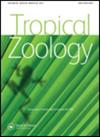Ecological characterization of mosquitoes (Diptera: Culicidae) in areas of the Mato Grosso Pantanal, Mato Grosso State, Brazil
IF 0.7
4区 生物学
Q4 ZOOLOGY
引用次数: 1
Abstract
Bimonthly diurnal and nocturnal captures were conducted in four different sampling sites of the Mato Grosso Pantanal region over 24 consecutive months between March 2009 and January 2011. The goal of performing these collections was to elucidate aspects of the biology and ecology of mosquitoes in this region since little to nothing is known about these aspects for many species. A total of 17,532 specimens were captured, comprising two subfamilies, nine genera, and 44 species. The main species of culicids found in the Mato Grosso Pantanal had strong ecological compatibility with well-preserved environments and with some of the specific habitats found in at least one of the four selected collection sampling sites. Anopheles darlingi, An. albitarsis, and An. triannulatus are well-suited to environments with large water bodies and greater anthropic activity. Culex nigripalpus and Cx. quinquefasciatus prefer environments with bush fragments and pronounced human action and movement. Culex declarator and Psorophora albigenu, the most eclectic, prefer wild areas and with some anthropic activity. Mansonia titillans is associated with environments offering a wide variety of natural breeding areas that enable its development, in particular natural swamp areas covered with macrophytes, which is one of the natural components of the Pantanal biome. The effect of the flooding season on the population density of anophelines is especially advantageous, with an explosion in the number of individuals in periods of widespread flooding. The region’s environmental dynamics are regulated by flooding cycles with alternating periods of flooding and drought, which are the main factors governing the ecology of the local fauna and flora. Flooding periods contribute to raising culicid species’ richness and diversity, while the droughts result in a more even distribution of specimens within species. The flooding season of the Pantanal occurs between November and May and coincides with the greatest abundance of culicid species. During this period, the human population of the region has greater contact with mosquito vectors carrying pathogens, including arboviruses, which previous studies have confirmed via seropositivity in the region’s equines and birds.巴西马托格罗索州潘塔纳尔地区蚊类生态学特征(双翅目:库蚊科
2009年3月至2011年1月,在马托格罗索-潘塔纳尔地区的四个不同采样点连续24个月进行了两个月的日间和夜间捕获。进行这些收集的目的是阐明该地区蚊子的生物学和生态学方面,因为对许多物种的这些方面知之甚少。共捕获17532个标本,包括两个亚科、九个属和44个物种。在马托格罗索-潘塔纳尔发现的主要库蚊物种与保存完好的环境以及在四个选定的采集采样点中至少一个采集点发现的一些特定栖息地具有很强的生态兼容性。darlingi按蚊、An.albitasis按蚊和An.trianulatus按蚊非常适合大型水体和人类活动较大的环境。黑库蚊和致倦库蚊喜欢有灌木碎片和明显的人类活动和活动的环境。Culex declarator和Psorophora albigenu是最折衷的,它们更喜欢野生地区,并有一些人类活动。Mansonia titillans与提供各种自然繁殖区的环境有关,这些自然繁殖区使其得以发展,特别是覆盖着大型植物的自然沼泽区,这是Pantanal生物群落的自然组成部分之一。洪水季节对按蚊种群密度的影响尤其有利,在大范围洪水期间,个体数量激增。该地区的环境动态受到洪水周期的调节,洪水和干旱交替,这是控制当地动植物生态的主要因素。洪水期有助于提高库利酸物种的丰富度和多样性,而干旱则使物种内的标本分布更加均匀。潘塔纳尔河的洪水季节发生在11月至5月之间,恰逢库利酸物种最丰富的时候。在此期间,该地区的人类与携带病原体的蚊子媒介有更多的接触,包括虫媒病毒,之前的研究已经通过该地区马和鸟类的血清阳性证实了这一点。
本文章由计算机程序翻译,如有差异,请以英文原文为准。
求助全文
约1分钟内获得全文
求助全文
来源期刊

Tropical Zoology
生物-动物学
CiteScore
2.50
自引率
0.00%
发文量
1
审稿时长
>12 weeks
期刊介绍:
Tropical Zoology is an international zoological journal publishing original papers in the field of systematics, biogeography, phylogeny, ecology and conservation of all terrestrial and aquatic animal Phyla from tropical and subtropical areas.
Only papers with new information, high quality and broad interest are considered. Single species description and checklists are not normally accepted. Review papers are welcome. The journal is owned by the Istituto di Ricerca sugli Ecosistemi Terrestri of the Consiglio Nazionale delle Ricerche, Florence, Italy (CNR-IRET) who performs research into the structure and functioning of aquatic and terrestrial ecosystems, focusing in particular on anthropogenic pressure and global change. The knowledge amassed forms the scientific basis for identifying the most appropriate protective and corrective interventions, and provides support for the bodies entrusted with formulating policies for environmental protection and recovery.
 求助内容:
求助内容: 应助结果提醒方式:
应助结果提醒方式:


